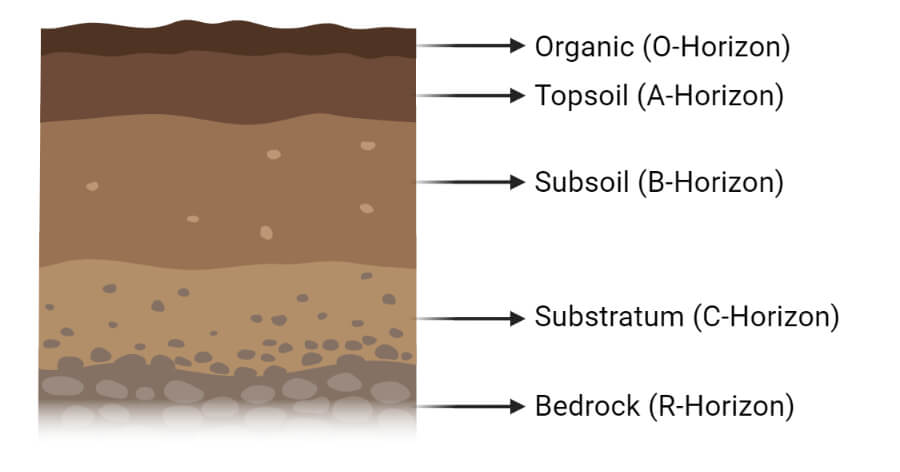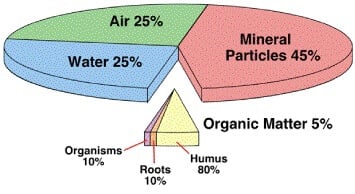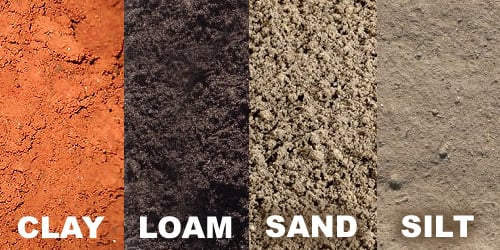Interesting Science Videos
What is Soil?
Soil is a biologically active porous medium that is present on the uppermost layer on the uppermost layer of the Earth’s crust formed by weathering processes under various influences.
- Soil acts as a substratum for life on Earth that serves as a reservoir of water and nutrients, a medium for the breakdown of organic materials, and as a participant of various biogeochemical cycles.
- The soil in any particular area evolves through a series of weathering processes that are influenced by biological, topographical, climatic, and geological factors.
- As studies on agriculture and geology have increased, the soil is now considered a complex, dynamic, biogeochemical system that is vital to the life cycles of various land vegetation and soil-inhabiting organisms.
- Soil is one of the most important elements of an ecosystem as it contains both biotic and abiotic components.

Figure: Soil Profile and Soil Horizon. Created with BioRender.com.
What is Soil moisture?
- Soil moisture is the volumetric water content of soil held within the spaces the soil particles or soil aggregates.
- Soil moisture is of two types; surface soil moisture is the water present on the upper layer of soil, whereas root zone moisture is the water available to plants, generally present within the soil.
- The moisture of the soil is considered an indicator of the quality of soil and the fertility of the soil.
What is Soil gas?
- Soil gases are different types of gases that are present within the pores between soil particles or soil aggregates.
- The gases found in soil include carbon dioxide, oxygen, and nitrogen. Other atmospheric gases include methane and radon.
- Pores in the soil are filled by gases after the water present in such pores are evaporated absorbed by the root.
- In the case of environmental contaminants, soil gas might include gases diffused from landfill wastes, mining activities, and petroleum products.
What is the Soil matrix?
- Soil matrix refers to all the solid particles found in soil that include the soil particles, organic matter, and other inorganic materials.
- The soil particles might either be sand, silt, or clay, the composition of which might differ from one type of soil to another and the location.
- Organic matter found in the soil matrix is humus which is the final stage of degradation of dead plants and animals.
- Humus might even form organic colloids with water and other inorganic substances.
- The soil matrix determines various physical and chemical properties of soil like water retention capacity, nutrient content, and pH.
Composition of Soil

Figure: Composition of Soil. Image Source: Professor Patricia Shapley, University of Illinois.
- Soil is composed of various factors like air, water, minerals, and different living and non-living organic compounds.
- The entire composition of soil can be classified as biotic and abiotic components; the abiotic component includes the non-living things of soil while the biotic component includes the living organisms.
- In general, the abiotic component of the soil accounts for about 40-45% of the soil volume followed by air and water that occupy 25% each with 5% covered by living things.
- The exact composition of the soil, however, might vary from place to place with the existing rocks of the area and the climate.
- Other factors like the quantity of vegetation, soil compaction, and water retention capacity also influence the composition of the soil of a particular area.
- The inorganic part of the soil is composed of rocks that are slowly broken down into smaller particles that might vary in size.
- The organic component of soil is called the humus, which is made up of living organisms like insects or microorganisms (dead or alive) and dead animals and plants in varying stages of decay.
Properties of Soil
The properties of soil are determined by the composition of the soil, depending on different amounts of biotic and abiotic components. The combinations of these components determine the physical and chemical properties of soil.
A. Physical Properties
The physical properties of soil include the following:
a. Soil Texture
- Soil texture refers to the size of the soil particles that is dependent on the relative proportions of mineral components like sand, silt, and clay.
- Soil texture is further influenced by soil porosity, infiltration, and water retention capacity.
- The texture of soil differs with soil type; sandy soil feels gritty, silt feels smooth, and clay is sticky and mouldable.
b. Soil Structure
- The textural components of soil, including sand, silt, and clay might result in aggregates as a result of their clumping. The aggregates further clump together to form peds.
- Information on the structure of soil gives information on the soil texture, matter content, and biological activity.
- Soil structure is influenced by physical processes that might be improved or destroyed by the choice of farming practices.
c. Soil Density
- The average soil particle density ranges from 2.60 to 2.75 grams per cm3, which usually remains unchanged for a given soil.
- The soil particle density is lower for soils with high organic matter content and higher for soil with higher mineral content.
- Soil particle density is different from soil bulk density which is always less than soil particle density.
- Soil density usually depends on the soil texture and structure and the composition of the soil.
d. Soil Porosity
- Soil porosity is defined by the number of pores present within the soil.
- The porosity of soil is determined by the movement of air and water within the soil.
- Healthy soils usually have more number of pores between and within soil aggregates, whereas poor quality soils have few pores or cracks.
- Soil porosity is influenced by soil texture and structure. The pore size in soil affects the ability of plants and organisms to access water, oxygen, and other gases and minerals.
e. Soil consistency
- Soil consistency refers to the ability of the soil to stick to itself or other objects and to resist deformation and rupture.
- Three moisture conditions define soil consistency; air-dry, moist, and wet.
- The consistency of dry soil ranges from loose to hard, whereas that of wet soil ranges from non-sticky to sticky.
- Soil consistency is an important property that determines the ability of soil to support buildings and roads.
f. Soil Colour
- Soil color is determined primarily by the organic composition of the soil.
- Soil color is one of the factors that help in the prediction of other soil characteristics within a soil profile.
- Observation of soil color is a qualitative means of measuring organic, iron oxide, and the clay contents of the soil.
- Besides, soil color is also influenced by the mineral content of the soil as the color might change as a result of oxidation of degradation.
B. Chemical properties
a. Cation exchange capacity (CEC)
- Cation exchange capacity is the maximum amount of total cations that a soil sample is capable of holding at a given pH.
- The cation exchange capacity of the soil is taken as an indicator of soil fertility, nutrient retention, and the ability of soil to protect groundwater from cation contamination.
b. Soil pH
- The reactivity of soil is expressed in terms of the soil pH, which determines the acidity and alkalinity of the soil.
- It is the measure of the hydrogen ion concentration in the aqueous solution of soil which ranges between 3.5 to 9.5.
- Usually, soils with high acidity contain higher amounts of aluminum and manganese, and soil with higher alkalinity has a higher concentration of sodium carbonate.
- In terms of soil fertility, agricultural production tends to be more in acidic soil.
c. Soil salinity
- Salts in the soil are transported from salt tables in water resources that then accumulate due to evaporation.
- Salinization of soil also occurs during irrigation processes from drainages. The salt accumulation affects the degradation of organic matter in soil and the vegetation on the soil.
- The most common salts that are present in soil include magnesium sulfate, potassium sulfate, and carbonates.
Types of Soil

Figure: Four major types of soil. Image Source: Wilson Bros Gardens.
Soil, in general, is classified into four different types depending on its composition and the size of particles. The four types of soil are:
A. Sandy Soil
- Sandy soil is a type of soil that contains a higher proportion of sand and less clay.
- Sandy soil is light, dry, and warm that tends to be more acidic than other types of soil.
- Because the size of the sand particle is larger than other particles, they have low water retention capacity and fewer nutrients.
- The lack of enough moisture and nutrients makes the soil less suitable for crop production.
- However, the soil can be made suitable by adding organic matter to increase water and nutrient content.
B. Clay Soil
- Clay soil is a type of soil that is comparatively heavy as it has higher water retention capacity and a higher concentration of nutrients.
- The soil is made up of over 25% clay particles that are smaller in size and thus hold a large amount of water.
- Clay soil drains water slowly and thus takes longer to warm up in the summer without drying out.
- However, because it is a heavy and dense type of soil, it doesn’t provide space for plant roots to flourish.
C. Silt Soil
- Silt soil is a light soil with a higher fertility rate with soil particles that are large than clay but smaller than sand.
- The soil is smooth and of fine quality that holds water better than the sandy soil.
- The soil can also be easily transported by moving currents, and it is found near water bodies.
- Silt soil is considered the best type of soil for agricultural practices as it has sufficient nutrients and enough moisture for plant growth.
D. Loam Soil
- Loam soil is a mixture of sand, silt, and clay soil that combines the properties of all three types of soil to make it more fertile.
- The soil has enough pores as well as water retention capacity to promote crop production.
- The level of calcium and pH of loam soil is also of the appropriate amount due to the presence of inorganic matter.
Functions of Soil
- Soil is the medium for plant growth as it provides an anchor for plant roots and acts as a water holding tank for necessary moisture.
- The degradation of plant and animal matter, i.e. the release and the binding of nutrients and trace elements, is one of the most important functions of soil organisms.
- Soil absorbs the water during rainfall and snowfall, which creates a pool of available water for plants and soil organisms.
- The absorbed water also moves downward through the soil profile towards the water bodies, thus acting as a regulator for water supplies.
- Soil is an essential part of biogeochemical cycles, where it allows the cycling of different organic and inorganic compounds from the atmosphere to the soil and back.
- Soil is a habitat for soil organisms as it provides necessary nutrients and water to living beings.
- Soil acts as the base for building homes, roads, and buildings, acting as a landscape or engineering medium.
- Soil provides the raw material for different purposes like clay for ceramic production.
References
- Schinner, F., Öhlinger, R., Kandeler, E., and Margesin, R. (2012). Methods in Soil Biology.Berlin: Springer
- Agricultural Microbiology. Indian Council of Agricultural Research. agrimoon.com
- Girvan MS, Bullimore J, Pretty JN, Osborn AM, Ball AS. Soil type is the primary determinant of the composition of the total and active bacterial communities in arable soils. Appl Environ Microbiol. 2003;69(3):1800-1809. doi:10.1128/aem.69.3.1800-1809.2003
- Balasubramanian, A.. (2017). Soil Forming Processes. 10.13140/RG.2.2.34636.00644.
- Northen TR, Zhang Z, Gao J, et al. Advancing Our Understanding of the Chemistry of Soil Microbiomes. In: National Academies of Sciences, Engineering, and Medicine; Division on Earth and Life Studies; Board on Chemical Sciences and Technology; Chemical Sciences Roundtable. The Chemistry of Microbiomes: Proceedings of a Seminar Series. Washington (DC): National Academies Press (US); 2017 Jul 19. 4.Available from: https://www.ncbi.nlm.nih.gov/books/NBK447357/
- Shen R, Pennell KG, Suuberg EM. Influence of Soil Moisture on Soil Gas Vapor Concentration for Vapor Intrusion. Environ Eng Sci. 2013 Oct;30(10):628-637. doi: 10.1089/ees.2013.0133. PMID: 24170970; PMCID: PMC3804323.
- Magdoff F. Concept, components, and strategies of soil health in agroecosystems. J Nematol. 2001;33(4):169-172.
- Jeffrey D.W. (1987) Soil matrix and soil water. In: Soil~Plant Relationships. Springer, Dordrecht. https://doi.org/10.1007/978-94-011-6076-6_8
Sources
- 2% – https://courses.lumenlearning.com/boundless-biology/chapter/the-soil/
- 2% – https://en.wikipedia.org/wiki/Physical_properties_of_soil
- 1% – https://www.slideshare.net/SumantDiwakar/soil-moisture
- 1% – https://www.sciencelearn.org.nz/resources/957-soil-properties
- 1% – https://www.nationalgeographic.org/encyclopedia/humus/
- 1% – https://www.britannica.com/science/soil
- 1% – https://weather.msfc.nasa.gov/landprocess/
- 1% – https://universalium.enacademic.com/199293/soil
- 1% – https://procivilengineer.com/types-of-soil/
- 1% – https://en.wikipedia.org/wiki/Mineral_soil
- 1% – http://www.fao.org/soils-portal/data-hub/soil-classification/numerical-systems/chemical-properties/en/
- 1% – http://www.fao.org/3/ac172e/ac172e04.htm
- 1% – http://self.gutenberg.org/articles/eng/Cation_exchange_capacity
- 1% – http://geoportal.pgi.gov.pl/surowce/skalne/ilaste_cement
- <1% – https://www.studymode.com/essays/Abiotic-And-Biotic-Components-1376398.html
- <1% – https://www.sciencedirect.com/topics/earth-and-planetary-sciences/soil-structure
- <1% – https://www.sciencedirect.com/topics/agricultural-and-biological-sciences/soil-color
- <1% – https://www.sciencedirect.com/science/article/pii/S0341816298000538
- <1% – https://www.quora.com/How-many-sand-particles-are-in-1kg
- <1% – https://www.pureairemonitoring.com/the-benefits-of-nitrogen-and-carbon-dioxide-for-food-processing/
- <1% – https://www.nrcs.usda.gov/wps/portal/nrcs/detail/national/newsroom/?cid=nrcs143_023543
- <1% – https://www.nationalgeographic.org/encyclopedia/soil-composition/
- <1% – https://www.gardenguides.com/article-clay-soil.html
- <1% – https://www.ctahr.hawaii.edu/mauisoil/a_factor_ts.aspx
- <1% – https://www.agronomy.k-state.edu/documents/nutrient-management/nmrg-soil-nutrients,-sources-and-uptake.pdf
- <1% – https://www.agrifarming.in/crops-suitable-for-sandy-soil-a-full-guide
- <1% – https://www.agdaily.com/crops/4-principles-creating-ideal-habitat-soil-benefitting-microorganisms/
- <1% – https://ucanr.edu/sites/gardenweb/files/29072.pdf
- <1% – https://socratic.org/questions/what-are-the-major-components-of-soil
- <1% – https://nepis.epa.gov/Exe/ZyPURL.cgi?Dockey=10002E2C.TXT
- <1% – https://landresources.montana.edu/nm/documents/NM8.pdf
- <1% – https://home.howstuffworks.com/what-is-loam-soil.htm
- <1% – https://en.wikipedia.org/wiki/Soils
- <1% – https://en.m.wikipedia.org/wiki/Soil_color
- <1% – https://agwaterexchange.com/2016/08/14/understanding-the-basics-of-water-in-soils/
- <1% – http://www.agrilearner.com/soil-colloids/

Wow nice notes
Wow!! I love it! Your informations are very useful, appreciate your work 🙏
Your notes are readible and understood easily,l have indeed liked them.Be blessed.
I love the note is quite interesting
Keep it up and God bless you 🙏 for this
I Love it so much keep it up and God bless you abundantly